Tailoring the Synthesis Method of Metal Oxide Nanoparticles for Desired Properties
Abstract
1. Introduction
2. SWOT Analysis of Metal Oxide Nanoparticle Synthesis
- Preparation of precursor solutions: Soluble metal salts (e.g., nitrates, chlorides) of the desired metal ions are dissolved in water to form precursor solutions.
- Precipitation: A precipitating agent (e.g., alkali hydroxide, ammonia) is added dropwise to the precursor solution, causing the formation of a metal hydroxide precipitate.
- Aging: The precipitate is aged at a specific temperature for a certain time to allow particle growth and crystallization.
- Washing and drying: The precipitate is washed with water or ethanol to remove impurities and then dried to obtain the metal oxide nanoparticles.
- Calcination: In many cases, the dried precipitate is calcined at high temperatures to convert the hydroxide into the desired metal oxide.
- Sol formation: Metal alkoxides or inorganic salts are dissolved in a suitable solvent (often alcohol) to form a sol, which is a stable colloidal suspension of nanoparticles.
- Gelation: The sol undergoes a process called gelation, where the particles aggregate to form a three-dimensional complex, resulting in a gel. This can be induced by hydrolysis and condensation reactions.
- The chosen template is prepared with the desired structure and pore size.
- Metal precursors are introduced into the template’s pores or channels.
- The metal precursors react and nucleate within the confined space of the template, forming nanoparticles.
- The template is removed, leaving behind the metal oxide nanoparticles with the desired shape.
3. Correlation between Synthesis and Properties of Metal-Oxide Nanoparticles
4. Functionalization of Metal Oxide Nanoparticles for Emerging Applications
5. Adaptive Modeling of Synthesis Conditions for Particle Size Control
6. Conclusions
Author Contributions
Funding
Data Availability Statement
Conflicts of Interest
References
- Subramani, K.; Ahmed, W. Nanotechnology and the Future of Dentistry. In Emerging Nanotechnologies in Dentistry: Processes, Materials and Applications; William Andrew: Norwich, NY, USA, 2011; pp. 1–14. [Google Scholar] [CrossRef]
- Yang, L. Fundamentals of Nanotechnology and Orthopedic Materials. In Nanotechnology-Enhanced Orthopedic Materials; Woodhead Publishing: Sawston, UK, 2015; pp. 1–25. [Google Scholar] [CrossRef]
- Hári, J.; Pukánszky, B. Nanocomposites: Preparation, Structure, and Properties. In Applied Plastics Engineering Handbook: Processing and Materials; Elsevier: Amsterdam, The Netherlands, 2011; pp. 109–142. [Google Scholar] [CrossRef]
- Ibrahim, I.D.; Jamiru, T.; Sadiku, E.R.; Hamam, Y.; Alayli, Y.; Eze, A.A. Application of Nanoparticles and Composite Materials for Energy Generation and Storage. IET Nanodielectrics 2019, 2, 115–122. [Google Scholar] [CrossRef]
- Shurygina, I.A.; Shurygin, M.G.; Sukhov, B.G. Nanobiocomposites of Metals as Antimicrobial Agents. In Antibiotic Resistance: Mechanisms and New Antimicrobial Approaches; Elsevier Inc.: Amsterdam, The Netherlands, 2016; pp. 167–186. [Google Scholar] [CrossRef]
- Mekuye, B.; Abera, B. Nanomaterials: An Overview of Synthesis, Classification, Characterization, and Applications. Nano Sel. 2023, 4, 486–501. [Google Scholar] [CrossRef]
- Chen, F.; Yan, T.H.; Bashir, S.; Liu, J.L. Synthesis of Nanomaterials Using Top-down Methods. In Advanced Nanomaterials and Their Applications in Renewable Energy, 2nd ed.; Elsevier: Amsterdam, The Netherlands, 2022; pp. 37–60. [Google Scholar] [CrossRef]
- Arbain, R.; Othman, M.; Palaniandy, S. Preparation of Iron Oxide Nanoparticles by Mechanical Milling. Miner. Eng. 2011, 24, 1–9. [Google Scholar] [CrossRef]
- Balachandran, A.; Sreenilayam, S.P.; Madanan, K.; Thomas, S.; Brabazon, D. Nanoparticle Production via Laser Ablation Synthesis in Solution Method and Printed Electronic Application—A Brief Review. Results Eng. 2022, 16, 100646. [Google Scholar] [CrossRef]
- Bosso, P.; Del Sole, R.; Milella, A.; Mengucci, P.; Barucca, G.; Armenise, V.; Bianco, G.V.; Fracassi, F.; Palumbo, F. Nanostructured Iron Oxide Thin Films Deposited by RF Sputtering as Catalysts for the Heterogeneous Solar Photo-Fenton Reaction. Vacuum 2023, 207, 111646. [Google Scholar] [CrossRef]
- Shaji, K.; Haviar, S.; Zeman, P.; Kos, Š.; Čerstvý, R.; Čapek, J. Controlled Sputter Deposition of Oxide Nanoparticles-Based Composite Thin Films. Surf. Coat. Technol. 2024, 477, 130325. [Google Scholar] [CrossRef]
- Nanolithography—An overview. ScienceDirect Topics. Available online: https://www.sciencedirect.com/topics/chemistry/nanolithography (accessed on 30 August 2024).
- Novembre, A.; Liu, S. Chemistry and Processing of Resists for Nanolithography. In Nanolithography: The Art of Fabricating Nanoelectronic and Nanophotonic Devices and Systems; Woodhead Publishing: Sawston, UK, 2013; pp. 194–286. [Google Scholar] [CrossRef]
- Elwakil, B.H.; Toderas, M.; El-Khatib, M. Arc Discharge Rapid Synthesis of Engineered Copper Oxides Nano Shapes with Potent Antibacterial Activity against Multi-Drug Resistant Bacteria. Sci. Rep. 2022, 12, 20209. [Google Scholar] [CrossRef]
- Hemben, A.; Chianella, I.; Leighton, G.J.T. Surface Engineered Iron Oxide Nanoparticles Generated by Inert Gas Condensation for Biomedical Applications. Bioengineering 2021, 8, 38. [Google Scholar] [CrossRef]
- Modan, M.; Schiopu, A.-G.; Marian Ducu, C.; Oproescu, M.; Magdalena Modan, E.; Schiopu, A.; Georgian Moga, S.; Aurelian Negrea, D.; Oproescu, M.; Gabriel Iana, V.; et al. The influence of precursors on the morpho-structure of zinc oxide. J. Sci. Arts 2024, 24, 399–408. [Google Scholar] [CrossRef]
- Ahmad, A.; Khan, Z.U.H.; Sabahat, S.; Sun, J.; Shah, N.S.; Khan, Z.U.; Muhammad, N.; Mir, S.; Rahim, A.; Nadeem, M.; et al. Innovations in Metal Oxides-Biochar Nanoparticles for Dye Removal. Nano-Struct. Nano-Objects 2024, 39, 101269. [Google Scholar] [CrossRef]
- Rehman, F.U.; Zada, Z.; Qayyum, I. Hydrothermal Synthesis of Copper Doped Zinc Oxide Nano Composites to Achieve Optimum Removal of Organic Pollutant Dye from Waste Water Following the Photo Catalytic Degradation. J. Nanomater. Mol. Nanotechnol. 2022, 11, 2. [Google Scholar]
- Han, Z.; Adeleye, A.S.; Keller, A.A. Engineered Nanomaterials for Water Treatment. Encycl. Nanomater. 2023, 1, 418–455. [Google Scholar] [CrossRef]
- Bumajdad, A.; Eastoe, J.; Zaki, M.I.; Heenan, R.K.; Pasupulety, L. Generation of Metal Oxide Nanoparticles in Optimised Microemulsions. J. Colloid. Interface Sci. 2007, 312, 68–75. [Google Scholar] [CrossRef]
- Alameen, A.S.; Undre, S.B.; Undre, P.B. Synthesis, Dispersion, Functionalization, Biological and Antioxidant Activity of Metal Oxide Nanoparticles: Review. Nano-Struct. Nano-Objects 2024, 39, 101298. [Google Scholar] [CrossRef]
- Mohandesi, M.; Tavakolian, M.; Rahimpour, M.R. Eggplant as an Appreciable Bio-Template for Green Synthesis of NiO Nanoparticles: Study of Physical and Photocatalytic Properties. Ceram. Int. 2022, 48, 22820–22826. [Google Scholar] [CrossRef]
- Kaur, A.; Bajaj, B.; Kaushik, A.; Saini, A.; Sud, D. A Review on Template Assisted Synthesis of Multi-Functional Metal Oxide Nanostructures: Status and Prospects. Mater. Sci. Eng. B 2022, 286, 116005. [Google Scholar] [CrossRef]
- Kousar, R.; Khan, Z.U.H.; Sabahat, S.; Sun, J.; Muhammad, N.; Shah, N.S.; Iqbal, J.; Khasim, S.; Salam, M.A. Synergetic Comparative Study: Photocatalytic and Biological Investigations of Green-Synthesized Metal Oxide Nanoparticles. Nano-Struct. Nano-Objects 2024, 38, 101184. [Google Scholar] [CrossRef]
- Purkayastha, D.D. Biogenic Synthesis of Silver Nanoparticles Using Lichens. In Green Synthesis of Silver Nanomaterials; Elsevier: Amsterdam, The Netherlands, 2022; pp. 513–523. [Google Scholar] [CrossRef]
- Aisida, S.O.; Onwujiobi, C.; Ahmad, I.; Zhao, T.-k.; Maaza, M.; Ezema, F.I. Biogenic Synthesis of Zinc Oxide Nanorods for Biomedical Applications and Photodegradation of Rhodamine B. Mater. Today Commun. 2022, 33, 104660. [Google Scholar] [CrossRef]
- Xie, W.; Zhang, Y.; Yang, X.; Yu, P.; Ban, D. Green Synthesis of Gold Nanoparticles Mediated by Extract of Curcuma Longa under Ultrasonic Condition: Investigation of Its Application for Reduction of Dye Pollutants and Repairing the Articular Cartilage in an Animal Model of Osteoarthritis of the Knee. Inorg. Chem. Commun. 2024, 162, 112169. [Google Scholar] [CrossRef]
- Aigbe, U.O.; Osibote, O.A. Green Synthesis of Metal Oxide Nanoparticles, and Their Various Applications. J. Hazard. Mater. Adv. 2024, 13, 100401. [Google Scholar] [CrossRef]
- Ahmed, S.; Annu; Chaudhry, S.A.; Ikram, S. A Review on Biogenic Synthesis of ZnO Nanoparticles Using Plant Extracts and Microbes: A Prospect towards Green Chemistry. J. Photochem. Photobiol. B 2017, 166, 272–284. [Google Scholar] [CrossRef]
- Aalami, Z.; Hoseinzadeh, M.; Hosseini Manesh, P.; Aalami, A.H.; Es’haghi, Z.; Darroudi, M.; Sahebkar, A.; Hosseini, H.A. Synthesis, Characterization, and Photocatalytic Activities of Green Sol-Gel ZnO Nanoparticles Using Abelmoschus Esculentus and Salvia Officinalis: A Comparative Study versus Co-Precipitation-Synthesized Nanoparticles. Heliyon 2024, 10, e24212. [Google Scholar] [CrossRef]
- Marycleopha, M.; Yaou Balarabe, B.; Adjama, I.; Moussa, H.; Anandaram, H.; Abdoul Razak, M.W. Anhydrous Sol-Gel Synthesis of TiO2 Nanoparticles: Evaluating Their Impact on Protein Interactions in Biological Systems. J. Trace Elem. Miner. 2024, 7, 100114. [Google Scholar] [CrossRef]
- Sugapriya, S.; Sriram, R.; Lakshmi, S. Effect of Annealing on TiO2 Nanoparticles. Optik 2013, 124, 4971–4975. [Google Scholar] [CrossRef]
- Sivayogam, D.; Kartharinal Punithavathy, I.; Johnson Jayakumar, S.; Mahendran, N. Study on Structural, Electro-Optical and Optoelectronics Properties of CuO Nanoparticles Synthesis via Sol Gel Method. Mater. Today Proc. 2022, 48, 508–513. [Google Scholar] [CrossRef]
- Liu, S.M.; Ding, W.Y.; Chai, W.P. Influence of Sb Doping on Crystal Structure and Electrical Property of SnO2 Nanoparticles Prepared by Chemical Coprecipitation. Phys. B Condens. Matter 2011, 406, 2303–2307. [Google Scholar] [CrossRef]
- Popov, N.; Ristić, M.; Bošković, M.; Perović, M.; Musić, S.; Stanković, D.; Krehula, S. Influence of Sn Doping on the Structural, Magnetic, Optical and Photocatalytic Properties of Hematite (α-Fe2O3) Nanoparticles. J. Phys. Chem. Solids 2022, 161, 110372. [Google Scholar] [CrossRef]
- Rahman, M.; Kamruzzaman, M.; Zapien, J.A.; Afrose, R.; Anam, T.K.; Liton, M.N.H.; Helal, M.A.; Khan, M.K.R. Conversion of N-Type to p-Type Conductivity in ZnO by Incorporation of Ag and Ag-Li. Mater. Today Commun. 2022, 33, 104278. [Google Scholar] [CrossRef]
- Zhou, N.; Zhang, Y.; Nian, S.; Li, W.; Li, J.; Cao, W.; Wu, Z. Synthesis and Characterization of Zn1-XCoxO Green Pigments with Low Content Cobalt Oxide. J. Alloys Compd. 2017, 711, 406–413. [Google Scholar] [CrossRef]
- Dengxin, L.; Guolong, G.; Fanling, M.; Chong, J. Preparation of Nano-Iron Oxide Red Pigment Powders by Use of Cyanided Tailings. J. Hazard. Mater. 2008, 155, 369–377. [Google Scholar] [CrossRef]
- Stepan, T.; Tété, L.; Laundry-Mottiar, L.; Romanovskaia, E.; Hedberg, Y.S.; Danninger, H.; Auinger, M. Effect of Nanoparticle Size on the Near-Surface PH-Distribution in Aqueous and Carbonate Buffered Solutions. Electrochim. Acta 2022, 409, 139923. [Google Scholar] [CrossRef]
- Modan, E.M.; Plăiașu, A.G. Advantages and Disadvantages of Chemical Methods in the Elaboration of Nanomaterials. In The Annals of “Dunarea de Jos” University of Galati. Fascicle IX, Metallurgy and Materials Science; Galati University Press: Galati, Romania, 2020; Volume 43, pp. 53–60. [Google Scholar] [CrossRef]
- Walton, K.S.; Snurr, R.Q. Applicability of the BET Method for Determining Surface Areas of Microporous Metal-Organic Frameworks. J. Am. Chem. Soc. 2007, 129, 8552–8556. [Google Scholar] [CrossRef]
- Shaji, A.; Zachariah, A.K. Surface Area Analysis of Nanomaterials. In Thermal and Rheological Measurement Techniques for Nanomaterials Characterization; Elsevier: Amsterdam, The Netherlands, 2017; Volume 3, pp. 197–231. [Google Scholar] [CrossRef]
- Kumar, S. The Effect of Elevated Pressure, Temperature and Particles Morphology on the Carbon Dioxide Capture Using Zinc Oxide. J. CO2 Util. 2014, 8, 60–66. [Google Scholar] [CrossRef]
- Upadhyay, R.K.; Pan, S.; Barman, A.; McLaughlin, J.A.; Roy, S.S. Oil Swollen Surfactant Gel Based Synthesis of Metal Oxides Nanoparticles: An Attractive Alternative for the Conventional Sol Gel Synthesis. Ceram. Int. 2016, 42, 12119–12128. [Google Scholar] [CrossRef]
- Veronesi, P.; Colombini, E.; Canarslan, Ö.S.; Baldi, G.; Leonelli, C. Procedure to Generate a Selection Chart for Microwave Sol-Gel Synthesis of Nanoparticles. Chem. Eng. Process.-Process Intensif. 2023, 189, 109383. [Google Scholar] [CrossRef]
- Alsolami, E.S.; Mkhalid, I.A.; Shawky, A.; Hussein, M.A. Metal Oxide-Combined Sol-Gel Synthesized Ceria Nanoparticles: An Operative Photocatalyst for Visible-Light-Driven Mineralization of Ciprofloxacin Antibiotic in Water. J. Phys. Chem. Solids 2024, 195, 112289. [Google Scholar] [CrossRef]
- Mohammed Salman, K.; Renuka, C.G. Modified Sol-Gel Technique for the Synthesis of Pure MgO and ZnO Nanoparticles to Study Structural and Optical Properties for Optoelectronic Applications. Mater. Today Proc. 2023, 89, 84–89. [Google Scholar] [CrossRef]
- Gutierrez-Sanchez, C.D.; Téllez-Jurado, L.; Dorantes-Rosales, H.J. Synthesis of Zirconia Nanoparticles by Sol-Gel. Influence of Acidity-Basicity on the Stability Transformation, Particle, and Crystallite Size. Ceram. Int. 2024, 50, 20547–20560. [Google Scholar] [CrossRef]
- Banitaba, S.H. Collaboration of Ultrasonic Irradiation and Silica Nanoparticles in the Diastereoselective Synthesis of Trans-2,3-Dihydrofuran Derivatives: An Exceptional Catalytic Activity of Sound Cavities and SiO2 Nanoparticles. Polycycl. Aromat. Compd. 2023, 43, 2321–2334. [Google Scholar] [CrossRef]
- Arularasu, M.V.; Vinitha, P.; Muthukrishnaraj, A. Ultrasonic Assisted Synthesis of Nanoporous Carbon/CeVO4 Nanocomposite for Supercapacitor and Photocatalytic Applications. Nano-Struct. Nano-Objects 2024, 39, 101305. [Google Scholar] [CrossRef]
- Kainat, S.; Gull, N.; Khan, S.M.; Zia, S.; Munir, S. Physicochemical Attributes, Structural Characterization, and Catalytic Properties of Nanomaterials. In Nanomaterials in Biomass Conversion: Advances and Applications for Bioenergy, Biofuels, and Bio-based Products; Woodhead Publishing: Sawston, UK, 2024; pp. 143–167. [Google Scholar] [CrossRef]
- Badri, A.; Slimi, S.; Guergueb, M.; Kahri, H.; Mateos, X. Green Synthesis of Copper Oxide Nanoparticles Using Prickly Pear Peel Fruit Extract: Characterization and Catalytic Activity. Inorg. Chem. Commun. 2021, 134, 109027. [Google Scholar] [CrossRef]
- Sha, R.; Basak, A.; Maity, P.C.; Badhulika, S. ZnO Nano-Structured Based Devices for Chemical and Optical Sensing Applications. Sens. Actuators Rep. 2022, 4, 100098. [Google Scholar] [CrossRef]
- Yang, B.; Tran, T.T.; Milam-Guerrero, J.A.; To, D.T.; Stahovich, T.; Myung, N.V. Enhancing Gas Sensing Performance of Tungsten Trioxide (WO3) Nanofibers through Diameter and Crystallinity Control. Sens. Actuators Rep. 2024, 7, 100182. [Google Scholar] [CrossRef]
- Das, A.; Peu, S.D.; Hossain, M.S.; Akanda, M.A.M.; Salah, M.M.; Akanda, M.M.H.; Rahman, M.; Das, B.K. Metal Oxide Nanosheet: Synthesis Approaches and Applications in Energy Storage Devices (Batteries, Fuel Cells, and Supercapacitors). Nanomaterials 2023, 13, 1066. [Google Scholar] [CrossRef]
- Oproescu, M.; Schiopu, A.G.; Calinescu, V.M.; Iana, V.G.; Bizon, N.; Sallah, M. Influence of Supplementary Oxide Layer on Solar Cell Performance. Eng. Technol. Appl. Sci. Res. 2024, 14, 13274–13282. [Google Scholar] [CrossRef]
- Manuja, A.; Kumar, B.; Kumar, R.; Chhabra, D.; Ghosh, M.; Manuja, M.; Brar, B.; Pal, Y.; Tripathi, B.N.; Prasad, M. Metal/Metal Oxide Nanoparticles: Toxicity Concerns Associated with Their Physical State and Remediation for Biomedical Applications. Toxicol. Rep. 2021, 8, 1970–1978. [Google Scholar] [CrossRef]
- Valdiglesias, V.; Touzani, A.; Ramos-Pan, L.; Alba-González, A.; Folgueira, M.; Moreda-Piñeiro, J.; Méndez, J.; Pásaro, E.; Fernández-Bertólez, N.; Laffon, B. Cytotoxic Effects of Zinc Oxide Nanoparticles on Human Glial Cells. Mater. Proc. 2023, 14, 23. [Google Scholar] [CrossRef]
- Miquel-Jeanjean, C.; Déric Cré Pel, F.; Ronique Raufast, V.; Payre, B.; Datas, L.; Bessou-Touya, S.; Lène Duplan, H. Penetration Study of Formulated Nanosized Titanium Dioxide in Models of Damaged and Sun-Irradiated Skins. Photochem. Photobiol. 2012, 88, 1513–1521. [Google Scholar] [CrossRef]
- Miu, D.-M.; Sha’at, F.; Neagu, G.; Albulescu, A.; Pavaloiu, R.-D.; Eremia, M.-C.; Jinga, S.-I. Biopolymer nanoparticles loaded with curcumin for biomedical applications. UPB Bull. Series B 2024, 86, 175–188. [Google Scholar]
- Tavares Luiz, M.; Santos Rosa Viegas, J.; Palma Abriata, J.; Viegas, F.; Testa Moura de Carvalho Vicentini, F.; Lopes Badra Bentley, M.V.; Chorilli, M.; Maldonado Marchetti, J.; Tapia-Blácido, D.R. Design of Experiments (DoE) to Develop and to Optimize Nanoparticles as Drug Delivery Systems. Eur. J. Pharm. Biopharm. 2021, 165, 127–148. [Google Scholar] [CrossRef]
- Khan, S.; Babadaei, M.M.N.; Hasan, A.; Edis, Z.; Attar, F.; Siddique, R.; Bai, Q.; Sharifi, M.; Falahati, M. Enzyme–Polymeric/Inorganic Metal Oxide/Hybrid Nanoparticle Bio-Conjugates in the Development of Therapeutic and Biosensing Platforms. J. Adv. Res. 2021, 33, 227–239. [Google Scholar] [CrossRef]
- Liu, B.; Liu, J. Sensors and Biosensors Based on Metal Oxide Nanomaterials. TrAC Trends Anal. Chem. 2019, 121, 115690. [Google Scholar] [CrossRef]
- Xu, H.; Yu, P.; Bandari, R.P.; Smith, C.J.; Aro, M.R.; Singh, A.; Ma, L. Bimodal MRI/Fluorescence Nanoparticle Imaging Contrast Agent Targeting Prostate Cancer. Nanomaterials 2024, 14, 1177. [Google Scholar] [CrossRef]
- Mathew, D.; Bhat, S.G. Statistical Design for Biogenesis of Melanin Nanoparticles from Producer Strain Pseudomonas Stutzeri BTCZ 109 through Taguchi DOE. Biocatal. Agric. Biotechnol. 2022, 42, 102366. [Google Scholar] [CrossRef]
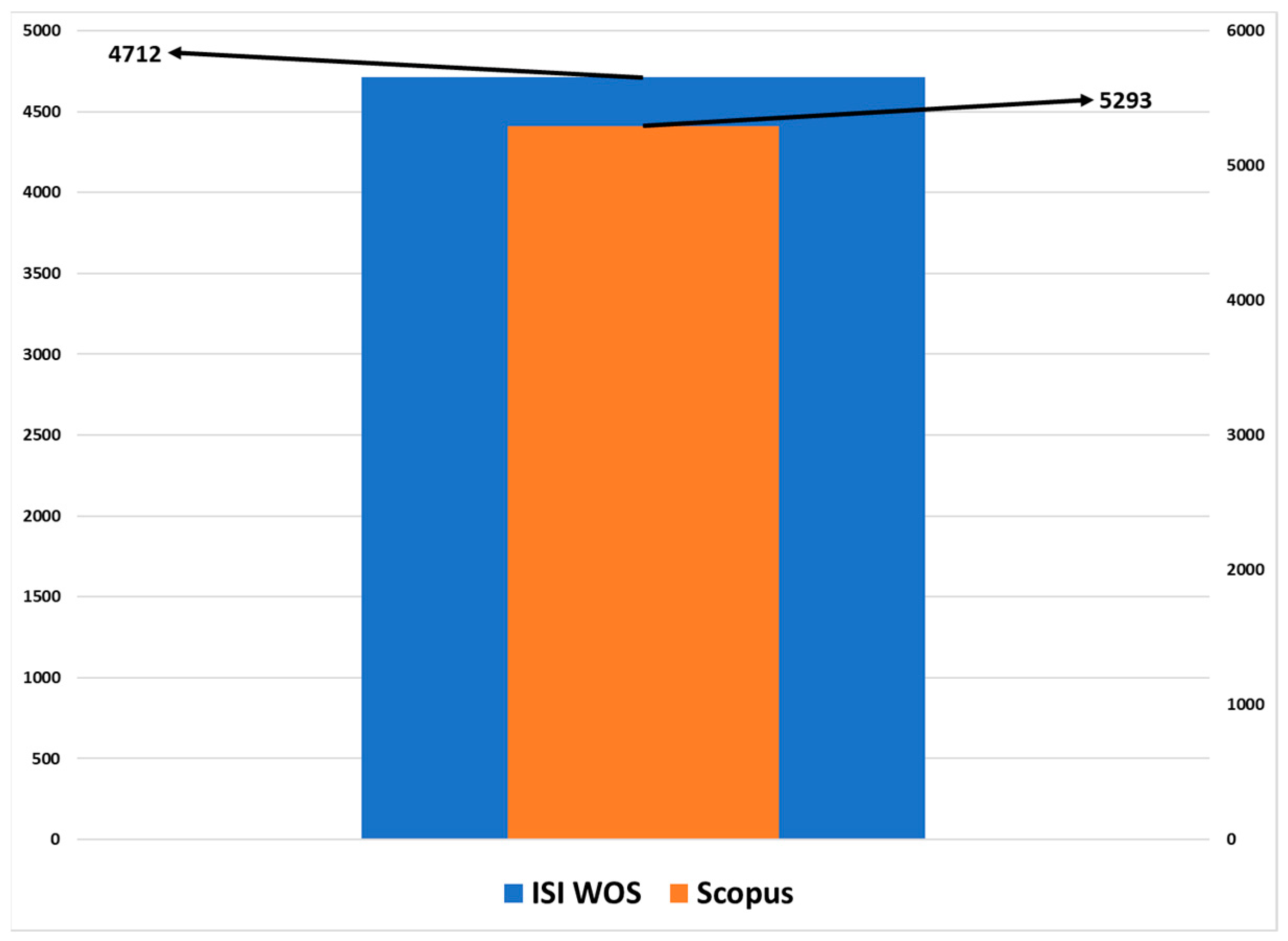
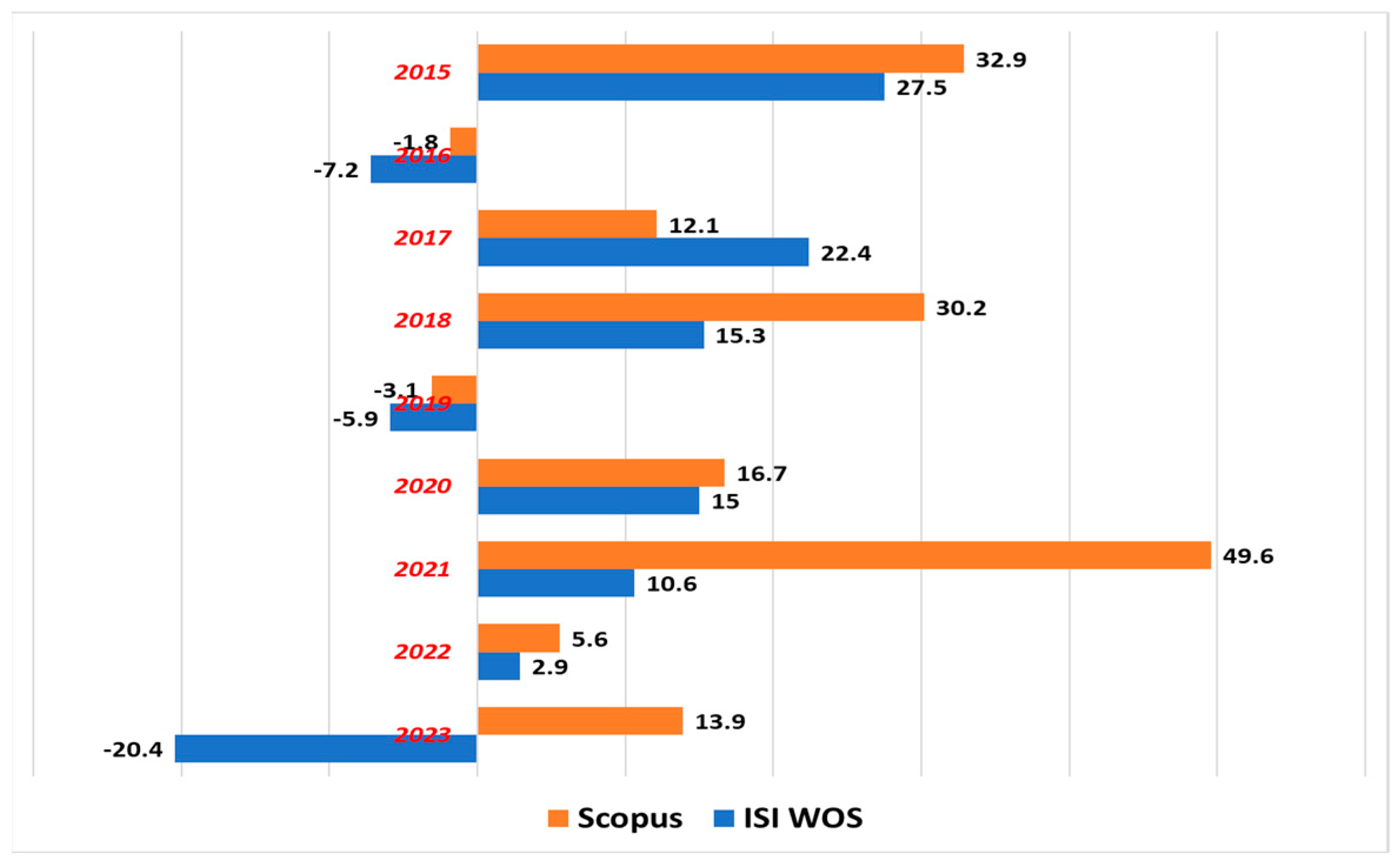
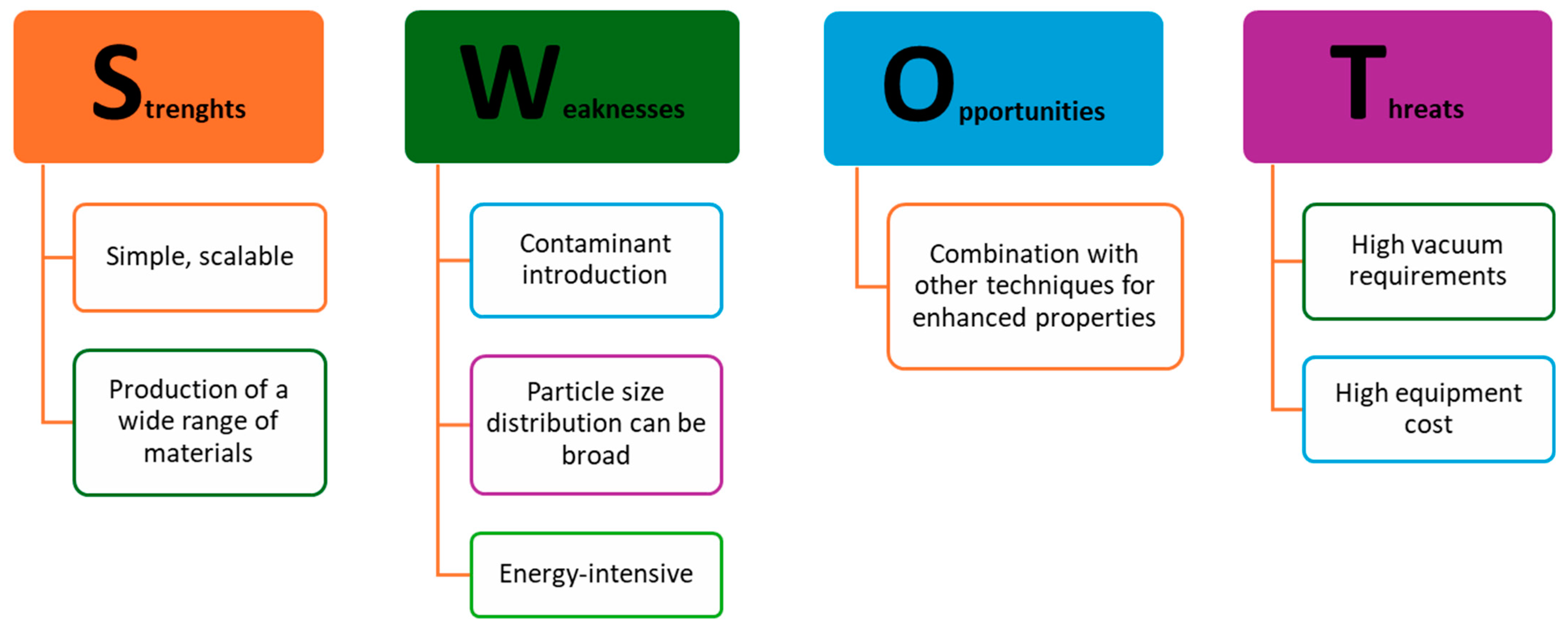
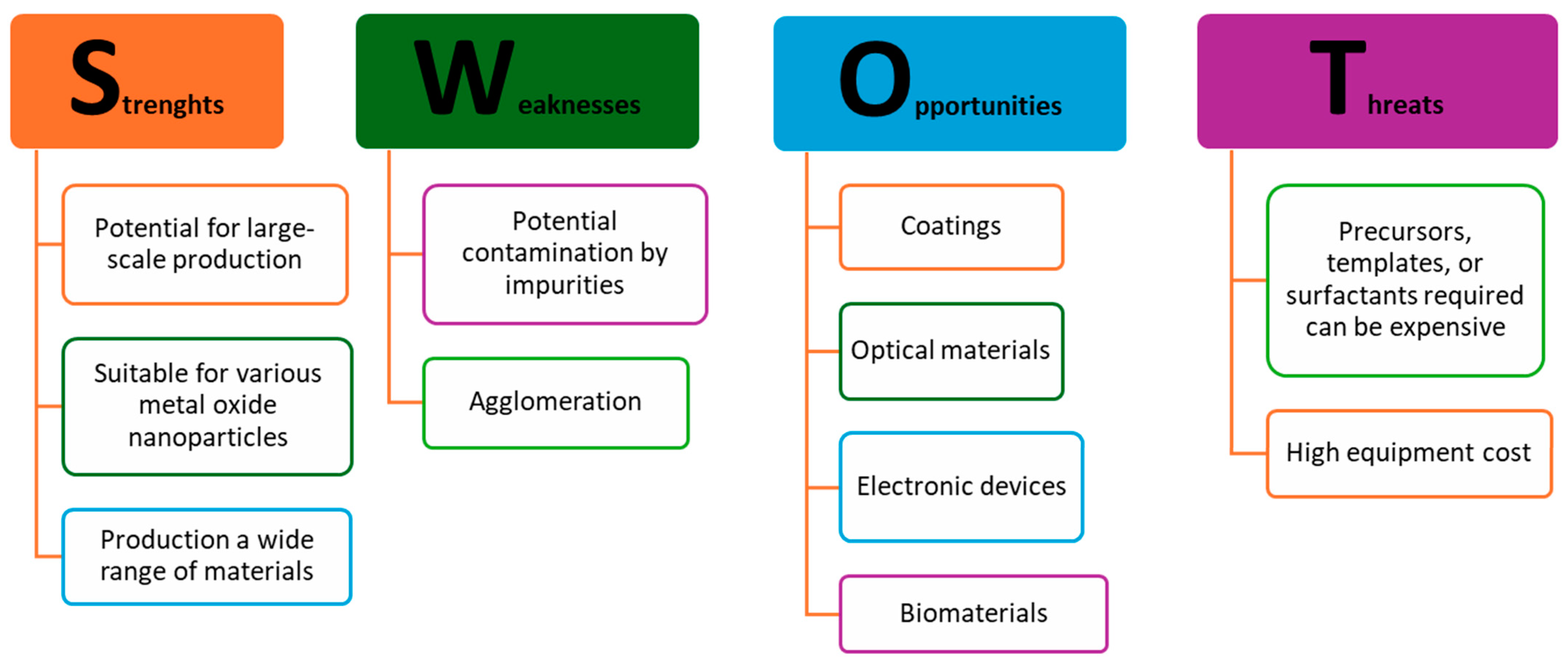
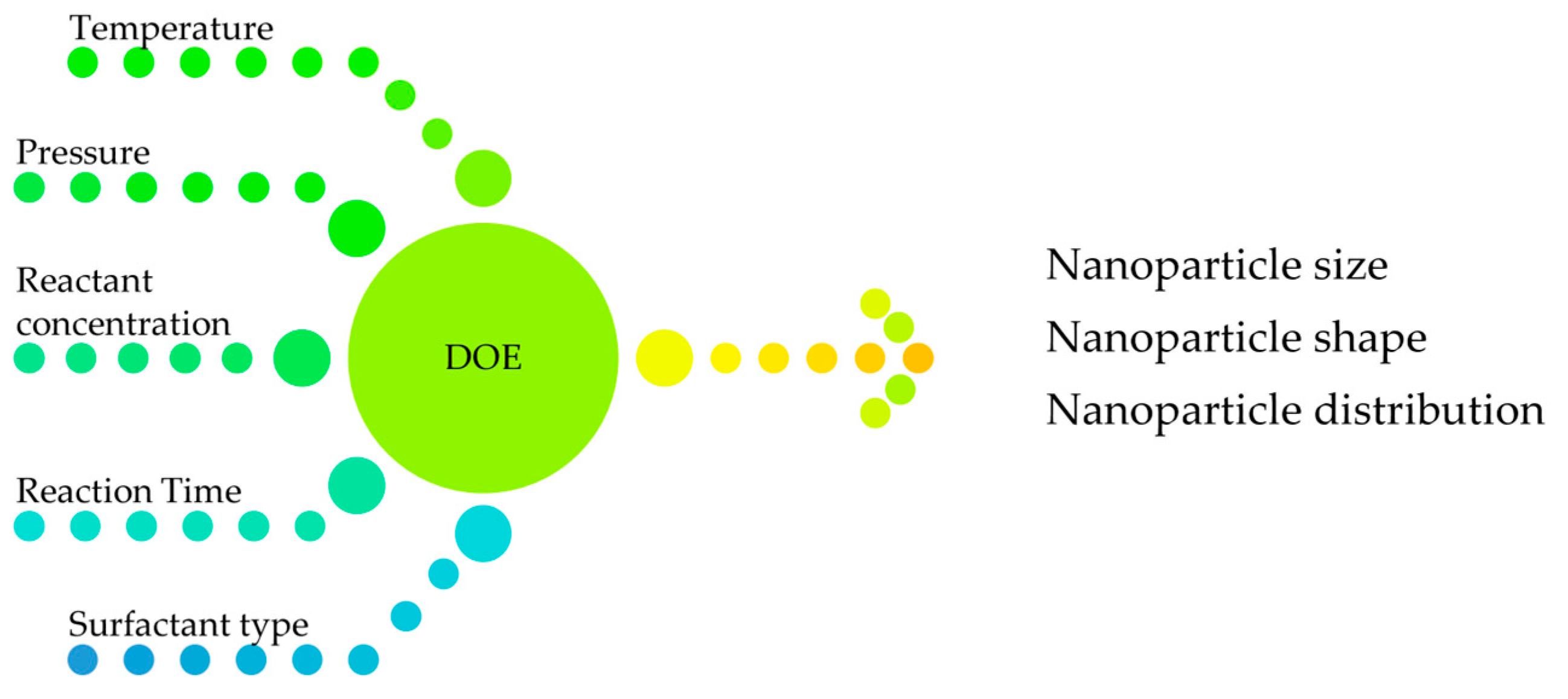
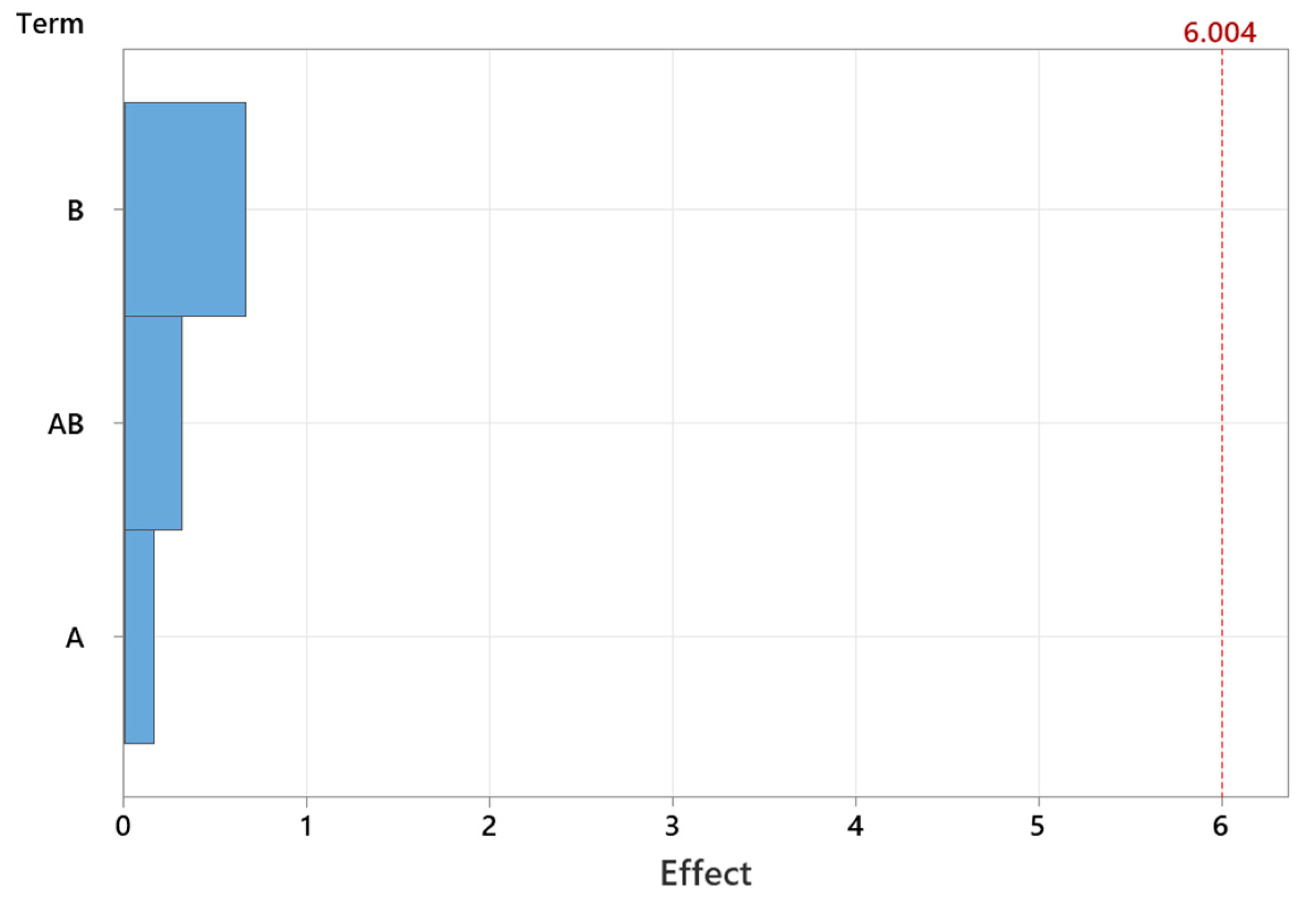
| Method | Advantages | Disadvantages |
|---|---|---|
| Mechanical milling | Simple, scalable, and can produce a wide range of materials | Simple, scalable, and can produce a wide range of materials |
| Laser ablation | High purity nanoparticles, precise control over particle size and shape | High equipment cost, low production yield |
| Sputtering | Versatile, can produce various materials, and good control over particle size | High vacuum requirements, expensive equipment, low deposition rates |
| Nanolithography | Precise control over particle size and shape, high resolution | Expensive, complex process, limited to planar structures |
| Method | Advantages | Disadvantages |
|---|---|---|
| Chemical reduction | Simple, inexpensive, and versatile | Difficult to control particle size and shape, often involves toxic chemicals |
| Precipitation and co-precipitation | Simple, inexpensive, and suitable for large-scale production | Difficult to control particle size and shape, often leads to agglomeration |
| Sol–gel | Versatile, good control over particle size and shape, and suitable for various materials | Time-consuming, requires careful processing, and can be sensitive to impurities |
| Hydrothermal | High-purity products, good control over particle size and shape, and suitable for various materials | High-pressure and temperature conditions |
| Micelle/microemulsion | Control over particle size and shape, prevents agglomeration | Complex process, requires surfactants, and often low yield, maintaining the stability of the microemulsion, complete removal of surfactant |
| Template-based | Precise control over particle size and shape, ordered structures | Template removal, expensive |
| Biologic | Environmentally friendly, low cost, biocompatible and potential for large-scale production of particles | Potential contamination by biological impurities |
| Experiment | Level Values | |
|---|---|---|
| CC | MP | |
| 1. | 1 | −1 |
| 2. | 1 | 1 |
| 3. | −1 | −1 |
| 4. | −1 | 1 |
| Experiment | Coded Values | Experimental Values | |
|---|---|---|---|
| CC (M) | MP (W) | DC (nm) | |
| 1. | 1 | 850 | 7.33 |
| 2. | 1 | 1000 | 6.35 |
| 3. | 0.5 | 850 | 7.18 |
| 4. | 0.5 | 1000 | 6.83 |
| Experiment | Coded Coefficients | |
|---|---|---|
| Effect | Coef | |
| 1. | Constant | 6.922 |
| 2. | −0.165 | −0.0825 |
| 3. | −0.315 | −0.1575 |
| 4. | 0.5 | 1000 |
Disclaimer/Publisher’s Note: The statements, opinions and data contained in all publications are solely those of the individual author(s) and contributor(s) and not of MDPI and/or the editor(s). MDPI and/or the editor(s) disclaim responsibility for any injury to people or property resulting from any ideas, methods, instructions or products referred to in the content. |
© 2024 by the authors. Licensee MDPI, Basel, Switzerland. This article is an open access article distributed under the terms and conditions of the Creative Commons Attribution (CC BY) license (https://creativecommons.org/licenses/by/4.0/).
Share and Cite
Schiopu, A.-G.; Iordache, D.M.; Oproescu, M.; Cursaru, L.M.; Ioța, A.-M. Tailoring the Synthesis Method of Metal Oxide Nanoparticles for Desired Properties. Crystals 2024, 14, 899. https://doi.org/10.3390/cryst14100899
Schiopu A-G, Iordache DM, Oproescu M, Cursaru LM, Ioța A-M. Tailoring the Synthesis Method of Metal Oxide Nanoparticles for Desired Properties. Crystals. 2024; 14(10):899. https://doi.org/10.3390/cryst14100899
Chicago/Turabian StyleSchiopu, Adriana-Gabriela, Daniela Monica Iordache, Mihai Oproescu, Laura Mădălina Cursaru, and Adriana-Miruna Ioța. 2024. "Tailoring the Synthesis Method of Metal Oxide Nanoparticles for Desired Properties" Crystals 14, no. 10: 899. https://doi.org/10.3390/cryst14100899
APA StyleSchiopu, A.-G., Iordache, D. M., Oproescu, M., Cursaru, L. M., & Ioța, A.-M. (2024). Tailoring the Synthesis Method of Metal Oxide Nanoparticles for Desired Properties. Crystals, 14(10), 899. https://doi.org/10.3390/cryst14100899








